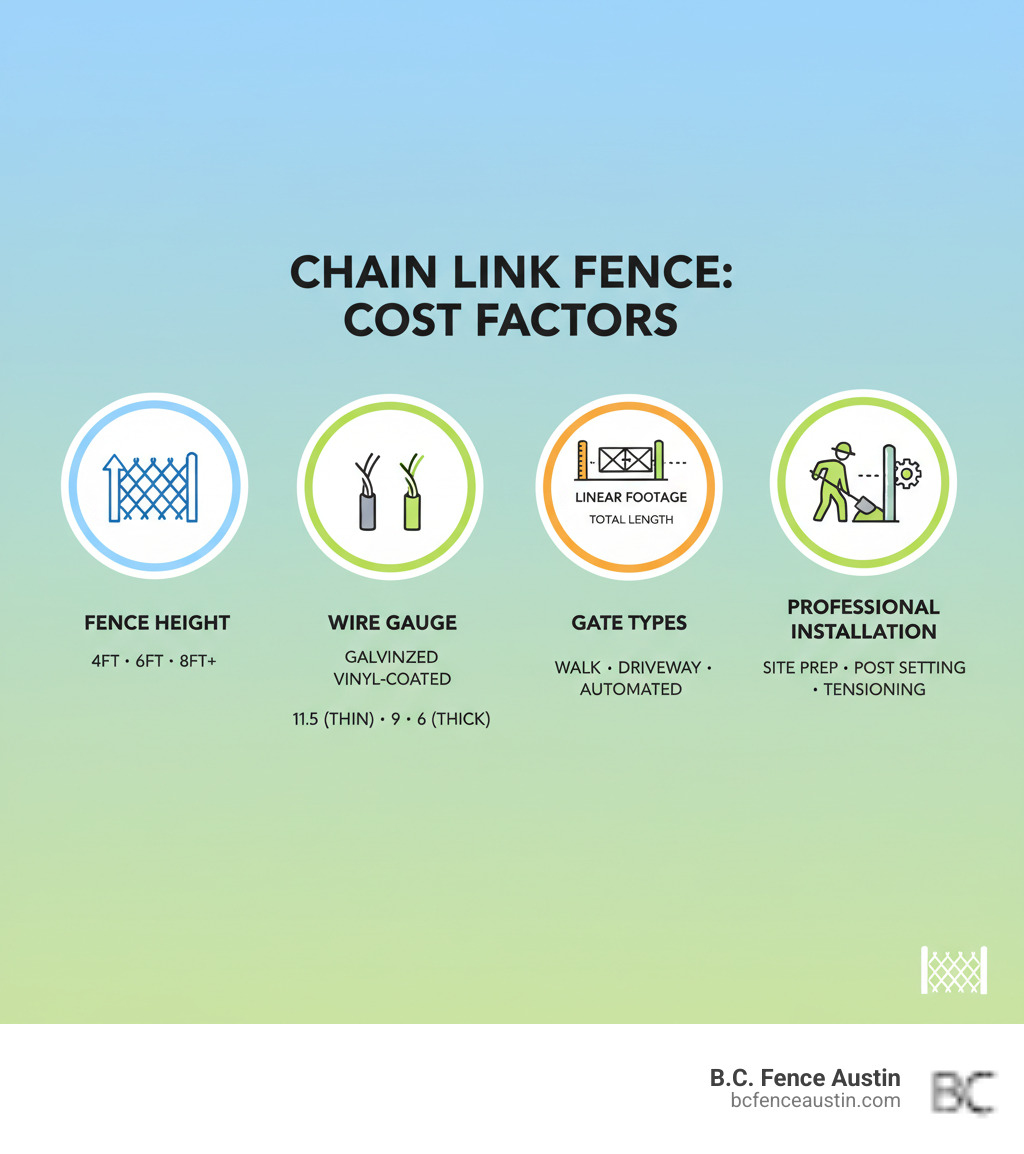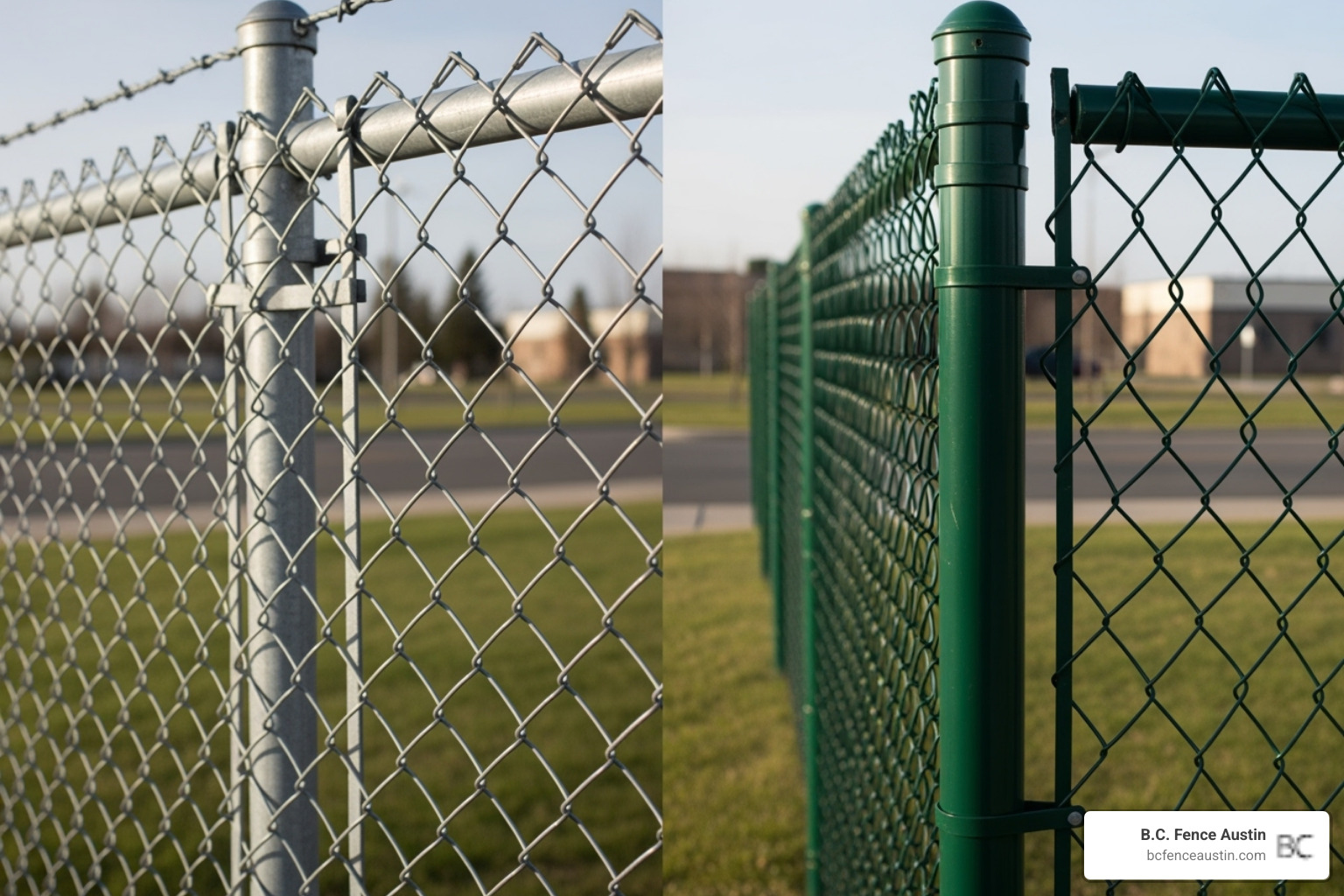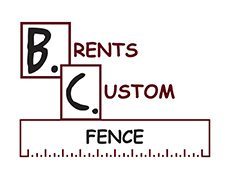Understanding What Drives Chain Link Fence Pricing
Chain link fence cost varies based on several key factors. A typical residential installation can range from an affordable baseline to a more substantial investment depending on the project’s height, materials, and complexity. Understanding these variables is crucial for planning your budget and making informed decisions about your property’s security.
Quick Answer: Chain Link Fence Cost Factors
- Fence Height: 4-foot fences are the most economical, while 6-foot and taller fences require more materials and labor.
- Wire Gauge: Thicker wire (lower gauge numbers like 9 or 6) costs more but offers greater durability than thinner 11.5-gauge wire.
- Material Finish: Standard galvanized steel is the budget-friendly option, while vinyl-coated fences add protection and aesthetic appeal.
- Linear Footage: The total length of your fence directly impacts material and labor expenses.
- Gates: Single walk gates are more affordable than double driveway gates or automated systems.
- Professional Installation: Labor adds to the cost but ensures proper tensioning and compliance with local codes.
Chain link fences remain one of the most affordable and practical fencing options for Austin homeowners. They offer excellent durability, require minimal maintenance, and provide clear visibility—making them ideal for keeping children and pets safe. The versatility of chain link means you can customize it to fit your specific needs and budget, from a basic perimeter to a more secure solution with privacy slats.
This guide breaks down every factor that influences your final investment, from wire gauge to post types, so you can make choices that align with both your security needs and your budget.

Breaking Down the Key Cost Factors
When planning a chain link fence for your Austin-area property, you’ll find the chain link fence cost is determined by several interconnected factors. The most straightforward is total linear footage—the length of fence you need. More fence means more materials and a higher total investment. For a deeper look at the components, see our guide on Chain Link Fence Details.
However, project complexity is just as important as length. A flat, rectangular yard is simple. Sloped terrain, rocky soil, multiple corners, or obstacles like trees increase the materials and labor required. At its core, a chain link fence consists of woven metal mesh (typically galvanized wire) stretched between metal posts set in concrete. This simple design is why it remains an affordable and practical choice. You can explore more about this versatile fencing style with this general information on chain link fencing.
How Fence Height, Wire Gauge, and Mesh Size Affect the Price
Your choice of fence height directly impacts the chain link fence cost. Taller fences require longer posts, more robust hardware, and more fabric. A standard 4-foot fence is the most economical option, perfect for defining boundaries or containing small pets. For greater security or privacy, a 6-foot or 8-foot fence is a better choice, though it represents a larger investment. Our Commercial Chain Link Fence Austin page has more information for business properties.
Next is wire gauge, which refers to the wire’s thickness. A lower gauge number means thicker, more durable wire. For example, 6-gauge wire is much stronger than the standard 11.5-gauge. While thicker wire increases the chain link fence cost, it provides superior resistance to damage and a longer lifespan. An 11.5-gauge fence is a budget-friendly solution for basic residential needs, but for serious security, upgrading to 9-gauge or 6-gauge wire is a worthwhile investment.
The size of the diamond-shaped openings in the mesh also affects function and cost. Most residential fences use a standard 2-inch diamond mesh, which balances visibility, containment, and cost. Smaller diamonds (e.g., 1-inch) make the fence harder to climb and cut, offering improved security and privacy. However, a tighter weave uses more wire, increasing the chain link fence cost.
The Role of Posts and Hardware in Your Budget
A fence is only as strong as its framework. Posts and hardware are critical to stability and longevity, representing a significant part of your chain link fence cost.
- Terminal posts are the corner, end, and gate posts. They are larger in diameter and set deeper in concrete to bear the tension of the stretched fabric, making them more expensive than line posts.
- Line posts are spaced every 8 to 10 feet to support the top rail and keep the fabric upright. Proper spacing is crucial to prevent sagging without overspending on unnecessary posts.
- The top rail runs horizontally across the top, providing rigidity and a finished look.
- Hardware, including tension bands, brace bands, nuts, bolts, and fence ties, holds everything together. Investing in quality hardware is essential, as cheap connectors can fail and compromise your entire fence, leading to more costly repairs down the road.
Material Choices and Their Cost Implications

Choosing the right material finish for your chain link fence affects your chain link fence cost, its lifespan, maintenance needs, and overall appearance. You’re not just buying a fence; you’re investing in your property’s security and curb appeal, so it’s worth understanding your options.
The Price Difference Between Galvanized and Vinyl-Coated Fences
Your two main choices are galvanized steel and vinyl-coated steel, each with distinct advantages.
Galvanized steel is the classic, budget-friendly option. The galvanization process coats steel wire with a protective layer of zinc, creating a barrier against rust and corrosion. This results in the familiar silver-grey fence that is functional, durable, and requires minimal maintenance, keeping the initial chain link fence cost manageable.
Vinyl-coated fencing adds an extra layer of PVC protection over the galvanized wire, offering superior defense against rust, corrosion, and weather damage. This option also provides aesthetic flexibility, as it comes in various colors like black, green, and brown. A colored fence can improve your property’s look instead of just serving a functional role. Explore our Chain Link Fence Color Options Guide to see how different colors might work for you.
| Feature | Galvanized Steel | Vinyl-Coated Steel |
|---|---|---|
| Durability | Excellent rust resistance due to zinc coating. | Superior rust and corrosion resistance; added protection. |
| Maintenance | Low; occasional cleaning and rust spot treatment. | Very low; cleaning suffices. |
| Aesthetics | Classic silver-grey, industrial look. | Available in colors (black, green, brown); modern look. |
| Initial Cost | More affordable. | Higher initial investment. |
While vinyl-coated options increase the initial chain link fence cost, many homeowners find the improved durability and improved appearance to be a worthwhile long-term investment.
Understanding Different Types of Coatings
Not all vinyl coatings are the same. The type of coating affects durability and cost.
- Extruded Vinyl: This is the entry-level option where vinyl is pressed onto the wire. It’s affordable but can be more vulnerable to chipping or peeling over time.
- Extruded and Bonded Vinyl: A step up in quality, this coating is chemically bonded to the wire, making it more resistant to cracking, peeling, and sun-fading. It’s a smart middle-ground choice for many residential properties.
- Thermally Fused Vinyl: This premium option involves a high-heat fusion process that makes the vinyl and wire practically inseparable. It offers maximum resistance to UV rays, corrosion, and physical damage. While it has a higher chain link fence cost, it’s ideal for those seeking maximum longevity, especially in Austin’s intense climate.
Beyond the Fence Line: Additional Cost Considerations

To accurately budget for your project, it’s important to consider elements beyond the basic fence line. These factors contribute to the total chain link fence cost and can include special materials, additional labor, or local requirements.
How Much Do Gates Add to the Total Cost?
Gates are essential access points and a significant part of your overall chain link fence cost. The price varies based on type, size, and features.
- Walk Gates: These narrow pedestrian gates are the most budget-friendly option, perfect for backyard paths.
- Driveway Gates: Designed for vehicles, these can be a single large panel (single swing) or two panels that meet in the middle (double swing). Double swing gates typically cost more.
- Rolling Gates: Also called slide gates, these glide horizontally along the fence line. They are a practical solution for tight spaces or wide driveways but are more complex and costly to install.
- Automatic Openers: For added convenience and security, openers can be added to swing or rolling gates. This premium feature includes motors, sensors, and remotes, increasing the chain link fence cost.
High-quality hardware, such as hinges and latches, also affects the gate’s price but ensures longevity and security.
Potential Additional Costs to Consider
Several other factors can influence your final chain link fence cost. Being aware of them helps prevent budget surprises.
- Site Preparation: Clearing brush, removing small trees, or grading uneven ground requires extra labor and may increase costs.
- Old Fence Removal: If you’re replacing an existing fence, the cost of removal and disposal will be added to your estimate.
- Permit Requirements: Many local governments, including those in the Austin area, require building permits for new fences, especially for taller installations. Permit fees vary by municipality.
- Property Survey: A professional survey ensures your fence is built on your property line, preventing potential disputes with neighbors.
- Difficult Terrain: Rocky soil, steep slopes, or numerous tree roots can make installation more challenging and time-consuming, leading to higher labor costs.
- Utility Location: Before digging, all utility lines must be located. Public utilities are marked for free, but you may need a paid service for private lines (e.g., to a pool or shed).
- Customizations: Features like privacy slats, decorative post caps, or barbed wire for added security will increase the material cost.
Professional Installation vs. DIY: A Cost-Benefit Analysis

One of the biggest decisions affecting your chain link fence cost is whether to install it yourself or hire professionals. While a DIY approach seems like a way to save on labor, it’s important to weigh the costs against the benefits of professional installation, such as time, required tools, and the quality of the finished product.
Analyzing Labor Costs and the DIY vs. Pro Difference
Professional labor is a significant part of the total chain link fence cost, but it covers more than just physical work. When you hire a professional crew, you’re paying for expertise, efficiency, and a quality guarantee.
Professional Installation:
- Expertise: Professionals understand how to handle challenges like rocky terrain, slopes, and proper post installation in concrete for maximum stability. They ensure the fence fabric is correctly tensioned to prevent sagging.
- Efficiency: An experienced crew can complete a project much faster than a DIYer, equipped with specialized tools like power augers and fence stretchers.
- Compliance & Warranty: Reputable installers ensure the fence meets local building codes and often provide a warranty on their workmanship, giving you peace of mind. Factors like project complexity and site accessibility will influence the final labor cost.
DIY Installation:
- Initial Savings: The primary appeal of DIY is avoiding labor costs. You’ll only pay for the materials.
- Hidden Costs: A DIY project requires renting or purchasing specialized tools. There’s also a significant time investment, which could take several days or weekends.
- Risk of Errors: Mistakes like improperly set posts or loose fabric can lead to an unstable fence that requires costly future repairs. Without professional experience, achieving a durable, long-lasting result can be difficult.
While DIY can lower the upfront chain link fence cost, the investment in professional installation often proves more cost-effective long-term by ensuring a durable, correctly installed fence. Our Chain Link Fence Installation Tips can offer valuable insights into the process, whether you hire a pro or not.
Frequently Asked Questions about Chain Link Fence Value

As fencing experts in the Austin area, we often get questions about the long-term value and comparative costs of chain link fences. Here are answers to some of the most common inquiries.
What is the expected lifespan of a chain link fence, and how does this relate to its value?
A key benefit of chain link fencing is its impressive lifespan. A standard galvanized steel fence can last 15 to 20 years, thanks to its rust-resistant zinc coating. If you upgrade to a vinyl-coated fence, you can expect an even longer life of 20 to 30 years or more, as the PVC layer provides superior protection against weather and UV rays.
This longevity, combined with very low maintenance needs, makes chain link a smart long-term investment. The initial chain link fence cost is spread over many years of reliable service, offering excellent value by minimizing long-term ownership expenses.
Are chain link fences cheaper than wood fences?
Yes, in most cases, chain link fences are more affordable than wood fences, both initially and over the long term. The chain link fence cost for materials and installation is typically lower than for a comparable wood fence.
Furthermore, chain link fences excel in long-term value. Wood fences require regular staining, painting, and repairs to combat rot, warping, and pests. These maintenance tasks add up in time and money. In contrast, chain link is virtually maintenance-free and naturally resistant to weather and pests. This durability and low upkeep make it a more budget-friendly choice over its lifespan. For other options, explore our Chain Link Fence Alternatives page.
Are there ways to optimize your investment in a chain link fence?
Absolutely. Even with their affordability, you can take steps to maximize your investment and manage your chain link fence cost effectively:
- Simplify the Layout: A design with fewer corners is more economical, as each corner requires a more expensive terminal post and extra hardware.
- Select Appropriate Materials: Match the materials to your needs. A standard 11.5-gauge galvanized fence may be sufficient for basic containment, while a heavier 9-gauge vinyl-coated fence is a smart investment for high-security needs.
- Phase the Project: If your budget is tight, consider installing the fence in sections. Start with the most critical areas and add more later as funds allow.
- Plan for the Long Term: A slightly higher initial investment in a more durable option like a vinyl-coated fence can pay off with a longer lifespan and lower maintenance costs, providing better value over time.
Conclusion: Making an Informed Fencing Decision
Estimating your chain link fence cost involves weighing several important choices. From the fence’s height and length to the wire gauge, mesh size, and gate styles, every decision plays a role in the final price. Your choice between classic galvanized steel and extra-protective vinyl-coated material will impact both the upfront cost and the fence’s long-term performance.
Remember to account for potential extra costs like site preparation and permits, and consider the trade-offs between a DIY project and professional installation. While DIY can save on labor, hiring a pro ensures quality, efficiency, and peace of mind.
A chain link fence is an excellent choice for many homeowners, combining affordability, durability, and low maintenance. By carefully considering all these factors, you can make a smart investment that delivers lasting security and improves your property’s appeal.
At B.C. Fence Austin, we specialize in providing secure and attractive fencing solutions across Austin and surrounding communities like Cedar Park and Leander. We understand the local landscape and regulations, ensuring a smooth installation.
Ready to improve your property? Let us guide you through the options and provide a clear, comprehensive estimate. Get a professional estimate for your Austin chain link fence project today!

